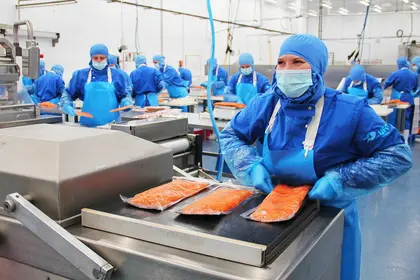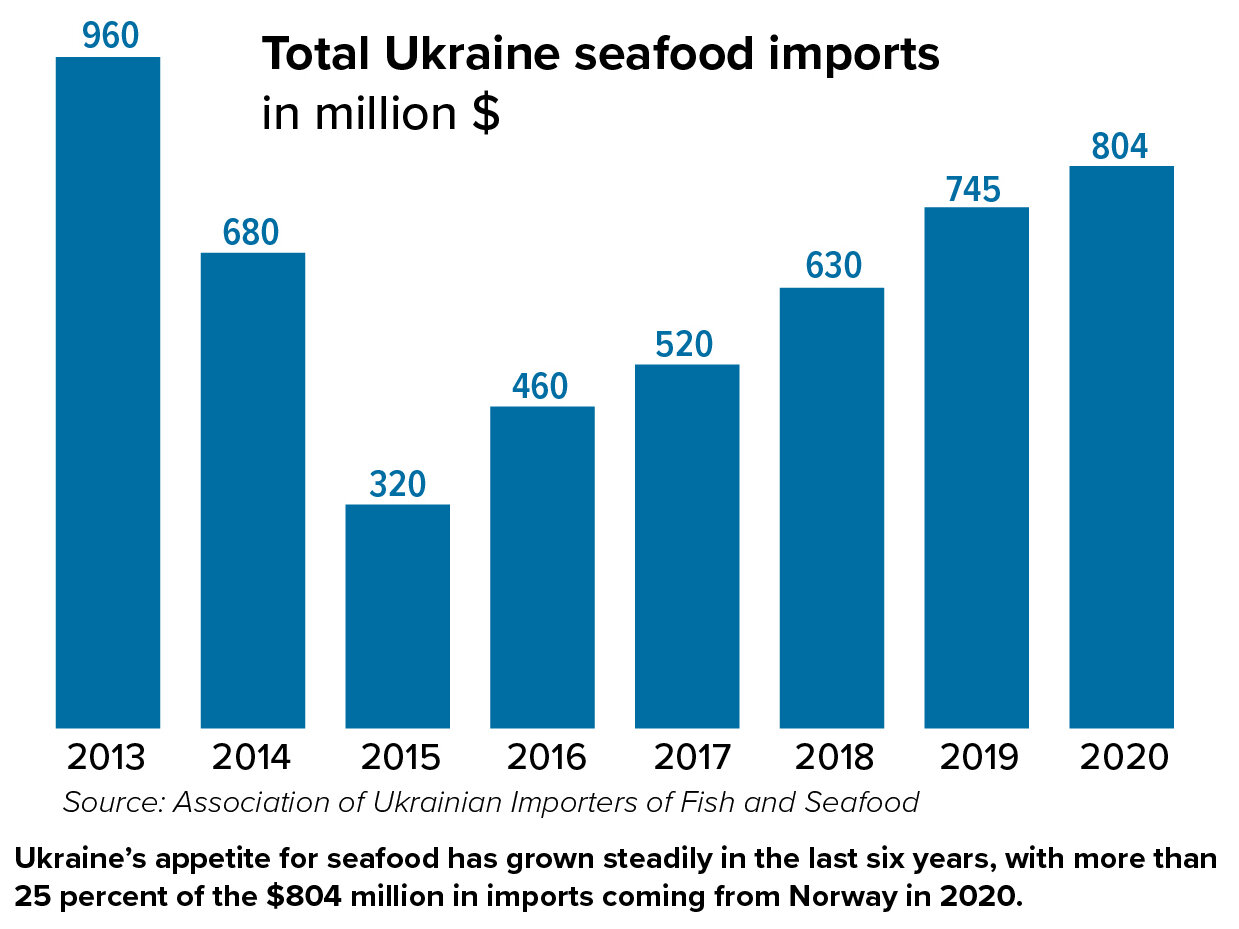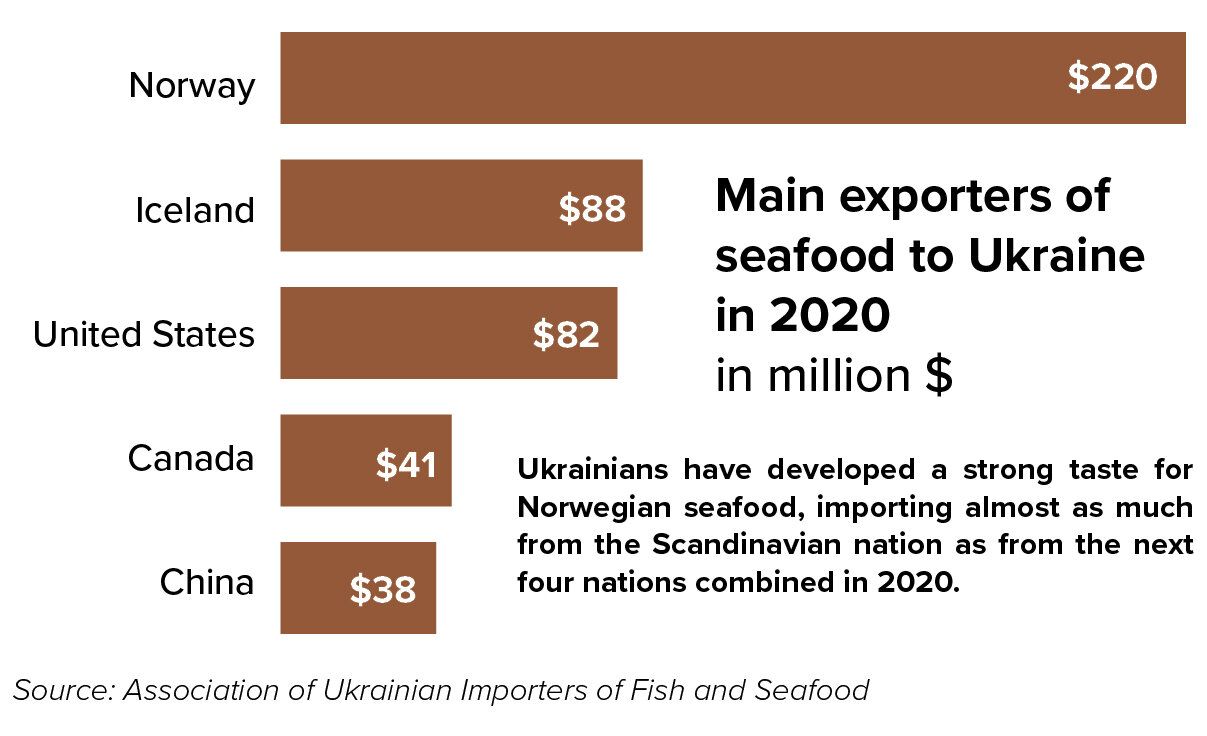Ukraine has the potential to become a major processing hub for Norwegian seafood — if Norwegian producers come to trust the investment climate here.
High labor costs in Norway have forced its seafood processors to look elsewhere. Approximately 95% of fish raised in Norway is shipped abroad for processing, according to Christen Mordal, consultant for the Norwegian Seafood Council.
JOIN US ON TELEGRAM
Follow our coverage of the war on the @Kyivpost_official.
Poland is currently a major processor of Norwegian seafood. Ever since Warsaw joined the European Union in 2004, Norwegian investments in fish processing plants have “skyrocketed,” says Stian Halsen, project manager at the Norwegian-Ukrainian Chamber of Commerce, whose 104 members include the Kyiv Post.
However, to protect its own producers, the EU has set “a lot of trading barriers” on the Nordic non-member, according to Halsen. Despite low labor costs, exporting raw seafood to an EU country like Poland still comes with substantial customs duty, he says.
Operating in Ukraine, however, would make it possible for Norwegian seafood exporters to circumvent EU trade barriers: there is currently no customs duty for most of the raw fish exported from Norway to Ukraine. Low labor costs in Ukraine can also attract Norwegian investors.
Once seafood is processed in Ukraine, it gains a Ukrainian origin and when exporting back to the EU carries almost no customs duty. Norwegian raw mackerel carries a 20% customs duty when it’s exported to Poland. To Ukraine, the customs duty would be close to nothing.
Oleg Kiriyevsky, managing partner at the First Chair Legal law firm, says it isn’t difficult for Norwegian seafood to gain a Ukrainian origin when exporting to the EU; it only needs to surpass minimal operation, which is little more than packaging and labeling the product.
A trade agreement made possible in September 2020 means this is still a new concept for both Norwegian investors and Ukrainian companies. And Norwegian companies will be looking for partners in Ukraine that comply with EU food safety regulations, which may pose a challenge. Still, “it’s a large, steadily growing market with untapped potentials,” Kiriyevsky says.
Rising star
Universal Fish Company (UFC) is the most prominent player in Ukraine when it comes to reprocessing Norwegian seafood and re-exporting it to other countries, including the EU, according to Halsen.
Roughly 70–80% of UFC’s imported fish comes from Norway, with salmon and trout being the most commonly reprocessed fish for further exports, according to Tatyana Krupenko, marketing director of the fish processing company in Ukraine.
In 2020, UFC’s overall revenue in the internal Ukrainian market was around Hr 5.6 billion ($206 million) and Hr 500 million ($18.4 million) in exports of reprocessed fish.
Though the majority of the reprocessed products stay in Ukraine, Krupenko says the next priority is to develop exports to other countries, particularly the EU. “We are trying to develop fish processing at an even higher level than Poland,” she says.
Krupenko says that the UFC is one of the few companies in Ukraine that owns processing centers and that is ready to cooperate with Norwegian exporters so that they can re-export more products with lower tariff rates to the EU.
The golden circle
Ukraine can also play an important role in the Norwegian seafood industry by providing fish feed to the Scandinavian country.
Norway imports “at least a couple of billions in dollars worth of fish feed” due to the lack of supply, according to Halsen. He says about 75% of what goes inside salmon and trout in Norwegian fish farms are plant-based, made of ingredients such as wheat, corn and rapeseed.
Ukraine grows most of the ingredients for the fish feed and yet it isn’t on the list of suppliers in the Norwegian aquaculture industry, Mordal says. Despite being known as the breadbasket of Europe, “basically none of it comes from Ukraine.”
Halsen thinks that Ukraine and Norway can create a “golden circle” together in the seafood sector: Ukraine can produce fish feed for Norwegian fish farms, and Norway can export raw seafood to Ukraine so it can be reprocessed there and re-exported to the EU and other countries.
In 2020, Ukraine imported $219 million of the total $804 million worth of seafood from Norway, the largest supplier of fish in the country, according to the State Customs Service of Ukraine.
“The seafood sector has a really huge untapped potential for bilateral trade,” Halson says.
Investments needed
Ukraine needs to improve its investment climate in order to attract Norwegian entrepreneurs.
While Norwegian exporters can work with Ukrainian companies that already own seafood processing facilities, Ukraine will only get the status of a hub when the Norwegian side decides to make further investments, says Kiriyevsky.
Despite the attractive almost zero-rated customs duty conditions that Ukraine offers, many Norwegian businesses have already invested in Poland, building dozens of fish processing facilities there. Halsen says it would be “too hard” to move the plants to another country. “Unfortunately, Ukraine was once more a bit late to the party,” Kiriyevsky said.
The cost of building a large, advanced seafood processing factory can be about 50 million euros, and Norwegian companies are not ready to take such a gamble in Ukraine yet, says Halsen. The country lacks transparency, predictability and security for investments.
To become an attractive investment destination, Halsen says that first Ukraine needs to make big progress in the World Bank’s Doing Business index by fighting corruption and reforming the judicial system.
You can also highlight the text and press Ctrl + Enter






